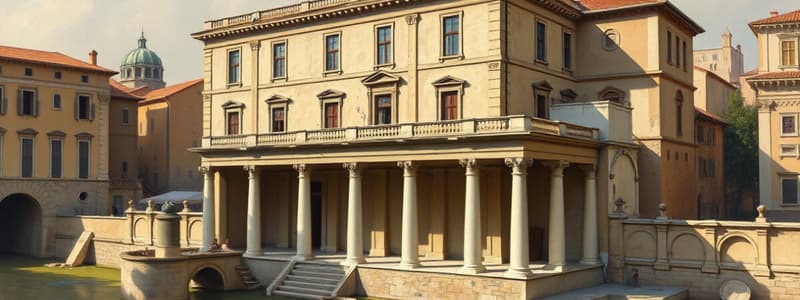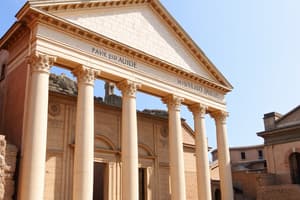Podcast
Questions and Answers
What construction technique did the Romans introduce that differed from Etruscan architecture?
What construction technique did the Romans introduce that differed from Etruscan architecture?
- Arcuated system (correct)
- Modular building
- Geometric masonry
- Post and lintel system
Which material was primarily used by the Romans for their architectural structures?
Which material was primarily used by the Romans for their architectural structures?
- Limestone
- Wood
- Bricks
- Marble (correct)
Which of the following is NOT a type of Roman structure mentioned?
Which of the following is NOT a type of Roman structure mentioned?
- Temples
- Bridges
- Cathedrals (correct)
- Aqueducts
How did political propaganda influence Roman architecture?
How did political propaganda influence Roman architecture?
What geological material did the Romans use to enhance their building techniques?
What geological material did the Romans use to enhance their building techniques?
Which of the following describes a characteristic of central Italy's climate that influenced architecture?
Which of the following describes a characteristic of central Italy's climate that influenced architecture?
What structural elements did the Romans develop that were distinct from Greek architecture?
What structural elements did the Romans develop that were distinct from Greek architecture?
What social change occurred in ancient Roman society over time?
What social change occurred in ancient Roman society over time?
What type of religion characterized ancient Rome?
What type of religion characterized ancient Rome?
Which architectural feature was developed by the Etruscans and later adopted by the Romans?
Which architectural feature was developed by the Etruscans and later adopted by the Romans?
Which of the following is NOT a characteristic of Roman architectural style?
Which of the following is NOT a characteristic of Roman architectural style?
What type of vault is created by two parallel walls extending throughout its length?
What type of vault is created by two parallel walls extending throughout its length?
Which architectural order is a simplified version of the Doric order?
Which architectural order is a simplified version of the Doric order?
Which of the following architectural elements is characterized by the intersection of two semi-circular vaults of equal span?
Which of the following architectural elements is characterized by the intersection of two semi-circular vaults of equal span?
Who was responsible for the inscription relating to the construction of a significant Roman building?
Who was responsible for the inscription relating to the construction of a significant Roman building?
What was a significant influence on Roman architecture aside from native developments?
What was a significant influence on Roman architecture aside from native developments?
What was the function of the Pantheon in ancient Rome?
What was the function of the Pantheon in ancient Rome?
What is Opus Incertum characterized by?
What is Opus Incertum characterized by?
Which Roman structure is known as the largest building in the Roman Forum?
Which Roman structure is known as the largest building in the Roman Forum?
Which construction technique is described as having a net-like effect?
Which construction technique is described as having a net-like effect?
What part of the Thermae is described as the warm room?
What part of the Thermae is described as the warm room?
Which Roman architectural technique utilizes concrete and specially made triangular baked bricks?
Which Roman architectural technique utilizes concrete and specially made triangular baked bricks?
What type of decorative art involves thousands of small stones forming a pattern?
What type of decorative art involves thousands of small stones forming a pattern?
Which of the following best describes Opus Mixtum?
Which of the following best describes Opus Mixtum?
What is the function of the Calidarium in the forum?
What is the function of the Calidarium in the forum?
Which part of the forum was commonly utilized for recreational activities?
Which part of the forum was commonly utilized for recreational activities?
What was the primary characteristic of the Roman Forum when compared to other forums?
What was the primary characteristic of the Roman Forum when compared to other forums?
Among the following, which temple is recognized as one of the largest and most splendid in Ancient Rome?
Among the following, which temple is recognized as one of the largest and most splendid in Ancient Rome?
What is the purpose of the Apodyteria in Roman architecture?
What is the purpose of the Apodyteria in Roman architecture?
Which type of structure was commonly found in the outer ring of apartments?
Which type of structure was commonly found in the outer ring of apartments?
What is the Sudatorium also called?
What is the Sudatorium also called?
Which component of Roman architecture was utilized for holding performances?
Which component of Roman architecture was utilized for holding performances?
Which architectural feature is characteristic of the Pantheon in Rome?
Which architectural feature is characteristic of the Pantheon in Rome?
What is the primary function of Roman amphitheaters?
What is the primary function of Roman amphitheaters?
Which type of Roman burial ground is known for holding ashes of the deceased?
Which type of Roman burial ground is known for holding ashes of the deceased?
What architectural component is primarily found in a traditional Roman domus?
What architectural component is primarily found in a traditional Roman domus?
Which of the following is NOT a classification of a Roman burial ground?
Which of the following is NOT a classification of a Roman burial ground?
What is the significance of the Circus in ancient Rome?
What is the significance of the Circus in ancient Rome?
Which type of Roman dwelling is described as a luxurious country house?
Which type of Roman dwelling is described as a luxurious country house?
In Roman architecture, what is the function of the Triclinia?
In Roman architecture, what is the function of the Triclinia?
Study Notes
Roman Architecture Overview
- Roman architecture is a blend of innovation, construction techniques, and creative design leading to iconic structures.
- Distinctive features include the use of the Arcuated System, incorporating a radiating arc and the Tuscan column.
Geological Influences
- Italy's central location in the Mediterranean facilitated the exchange of art and civilization across Europe, Western Asia, and North Africa.
- Key building materials included travertine, tufa, and marble, primarily for finishes.
- Pozzolana, a sand-like material mixed with lime, was crucial in Roman construction.
Historical Context
- The emergence of Rome as a powerful state amid numerous city-states on the Italian peninsula.
- Rome's strategic northern Mediterranean location contributed to its expansion into one of history's strongest empires.
- Significant political organization developed, including governance by provincial governors and the establishment of Latin as the official language.
Etruscan Influence
- Early inhabitants of Central Italy, the Etruscans, possessed substantial architectural knowledge that influenced Roman design.
- They utilized the true radiating arch and solid cyclopean masonry for construction.
Architectural Characteristics
- Vastness and magnificence define Roman buildings, often featuring ostentation and ornateness.
- Adoption of Greek columnar and trabeated styles alongside the development of the arch, vault, and dome.
- Usage of different vault types, including tunnel vaults, wagon vaults, hemispherical domes, and cross vaults.
Significant Structures and Types
- Forums served as central places for public and market activities, with the Roman Forum as a notable example.
- Temples, like the Pantheon and the Temple of Venus, exemplify Roman religious architecture and dedication to gods.
- Basilicas functioned as courts and public buildings, with the Basilica of Constantine being one of the largest.
- Theaters and amphitheaters, such as the Colosseum, became integral for entertainment and spectacle.
Public Baths (Thermae)
- Thermae were public bathing complexes featuring a main building, tepidarium (warm room), calidarium (hot room), and frigidarium (cold section).
- Additional amenities included dressing rooms, a library, and spaces for social activities.
Tombs and Dwelling Houses
- Roman burial grounds, including catacombs, featured various types such as coemetra, monumental tombs, and cenotaphs.
- Dwelling types included domus (private houses), villas (luxurious country houses), and insulae (tenement houses) organized around atriums and communal spaces.
Decoration Techniques
- Mosaics utilized thousands of small stones to create patterns, enhancing the aesthetic of Roman spaces.
- Construction techniques varied, including opus incertum and opus reticulatum to achieve different visual effects in masonry.
Religion and Society
- Roman religion was polytheistic, dominated by mythology while lacking a sacramental priesthood.
- Wealth and urban density necessitated architectural innovations and served political propaganda through monumental architecture.
Studying That Suits You
Use AI to generate personalized quizzes and flashcards to suit your learning preferences.
Related Documents
Description
Explore the innovations and techniques of Roman architecture, focusing on its distinctive features such as the Arcuated System and Tuscan columns. Understand the geological influences and historical context that shaped this iconic style and fueled Rome's expansion as a powerful state.




